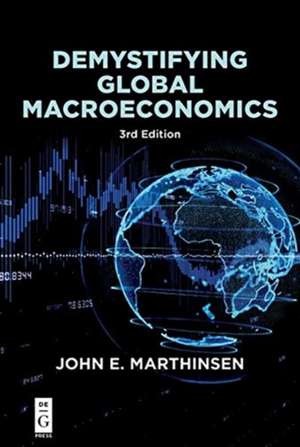Demystifying Global Macroeconomics
Autor John E. Marthinsenen Limba Engleză Paperback – 10 feb 2020
John E. Marthinsen integrates the three major macroeconomic sectors, which are the credit market, goods and services market, and foreign exchange market. The author provides the reader with contemporary examples that virtually leap off the front pages of our daily news reports and confront business managers and politicians with choices and decisions to make. For example, DGM shows how to use macroeconomic tools and a global framework to analyze the effects of:
- U.S. tariffs on China and China's tariffs on the United States
- Infrastructure spending
- Speculative capital outflows from nations under stress, such as Argentina and Turkey, and speculative capital inflows into safe-haven countries, such as Switzerland
- Demonetization in India
- Successfully fighting the opioid abuse problem in the United States
- Border adjustment tax
- Monetary policies
- Fiscal policies
If you are adopting this book for a teaching course, please contact Stefan.Giesen@degruyter.com to request additional instructional material.
Preț: 431.75 lei
Preț vechi: 533.02 lei
-19% Nou
Puncte Express: 648
Preț estimativ în valută:
82.64€ • 89.80$ • 69.46£
82.64€ • 89.80$ • 69.46£
Carte tipărită la comandă
Livrare economică 17-23 aprilie
Preluare comenzi: 021 569.72.76
Specificații
ISBN-13: 9781547417605
ISBN-10: 1547417609
Pagini: 844
Dimensiuni: 155 x 230 x 45 mm
Greutate: 1.36 kg
Ediția:3rd Edition
Editura: De Gruyter
ISBN-10: 1547417609
Pagini: 844
Dimensiuni: 155 x 230 x 45 mm
Greutate: 1.36 kg
Ediția:3rd Edition
Editura: De Gruyter
Cuprins
1. Introduction to International Macroeconomics. Part I: UNDERSTANDING A NATION'S ECONOMIC CONDITIONS. 2. Taking an Economic Pulse: Measuring National Output. 3. Monitoring Labor Market Conditions. 4. Inflation, Real GDP, and Business Cycles. 5. Inflation: Who Wins, and Who Loses? Part II: REAL LOANABLE FUNDS MARKET. 6 Monetary Aggregates: Measuring Money. 7. Financial Intermediation, Market, and Intermediaries. 8. The Power of Financial Institutions to Create Money. 9. Who Controls the Money Supply and How? 10. The Economics of Virtual Currencies. 11. Interest Rates and Why They Change. Part III: THE REAL GOODS SECTOR. 12. Price and Output Fluctuations. 13. Fiscal Policy and Automatic Stabilizers: What Managers Need to Know. Part IV: FOREIGN EXCHANGE MARKET. 14. Basics of Foreign Exchange Markets. 15. Exchange Rates: Why Do They Change? 16. Balance of Payments Fundamentals. Part V: SHORT-TERM ECONOMIC CHANGES: PUTTING IT ALL TOGETHER. 17. Putting It All Together. 18. Economic Shocks to Nations with Flexible Exchange Rates. 19. Economic Shocks to Nations with Fixed Exchange Rates. 20. Causes and Consequences of the Great Recession. Part VI: LONG-TERM ECONOMIC CHANGES. 21. Causes of Long-Term Growth and Inflation. 22. Long-Term Exchange Rate Movements and Comparative Advantage.
